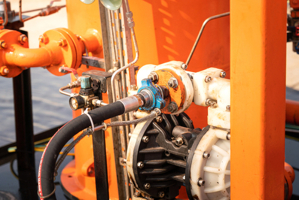Everything About High-Pressure Pipe Fittings

Figure 1: High-pressure hose attached to a metal pipe using suitable fittings
High-pressure fittings are specialized components that maintain integrity and withstand extreme pressure conditions. They ensure leak-free connections and reliable performance when handling fluids or gasses under high pressure. This article explores high-pressure pipe fittings' features, types, and applications.
What are high-pressure pipe fittings?
High-pressure pipe fittings are plumbing fittings used to make pipe connections. Unlike standard fittings, they can handle compressed gasses or liquids at high pressures. They are engineered with a safety factor, which is an additional margin of safety above the expected operating pressure.
Pressure range in pipe fittings
- Low to medium-high pressure: Pressure ratings range from approximately 69 bar (1,000 PSI) to 414 bar (6,000 PSI), suitable for hydraulic systems, pneumatic systems, and certain industrial applications.
- High pressure: Designed for even higher pressures, with ratings from approximately 414 bar (6,000 PSI) to 690 bar (10,000 PSI), commonly used in high-pressure hydraulic systems, oil and gas industry applications, and specialized industrial processes.
- Ultra-high pressure: Engineered to handle extremely high pressures, with ratings above 690 bar (10,000 PSI) up to approximately 1034 bar (15000 PSI), utilized in industries such as oil and gas exploration, water jet cutting, and high-pressure testing applications.
High-pressure pipe fitting features
High-pressure fittings have higher pressure ratings than normal, indicating maximum working pressure without failure. Some of the features of these fittings are listed below:
- Robust construction: High-pressure fittings are built with heavy-duty materials and sturdy construction to withstand the pressure exerted by pressurized fluids or gasses.
- Enhanced sealing capability: High-pressure fittings employ advanced sealing mechanisms to prevent leakage under extreme pressures. They may incorporate double ferrule compression fittings, o-rings, gaskets, or metal-to-metal seals.
- Material selection: Common materials used to manufacture high-pressure pipe fittings include stainless steel, nickel-base alloy steel, copper-nickel alloy steel, titanium alloy, carbon steel, low-temperature steel, alloy steel, and high-yield steel, chosen for their strength, corrosion resistance, and durability.
- Threading design: High-pressure fittings often feature tapered threads, such as NPT (National Pipe Taper) or BSPT (British Standard Pipe Taper) threads. Tapered threads provide a more secure seal as the tightening action compresses the threads, creating a tight fit.
- Reinforced connections: High-pressure fittings may feature additional reinforcement, such as thicker walls or extended nuts, to provide added support and strength.
-
Compliance with standards: High-pressure fittings adhere to specific industry standards and regulations like ASME B16.11, ASME B31.3, ISO 228-1, and ASTM A105.
- ASME B16.11: Covers the requirements for forged steel fittings, socket-welding, and threaded
- ASME B31.3: Provides guidelines for the design, construction, and inspection of piping systems, including high-pressure applications
- ISO 228-1: Specifies the requirements for parallel internal and external pipe threads
- ASTM A105: Covers carbon steel forgings for piping applications
- Precision machining: High-pressure fittings undergo precise machining processes to ensure accurate dimensions and tight tolerances. This guarantees a secure and leak-free connection when joining the fittings with pipes or other components.
- Testing and certification: High-pressure fittings typically undergo rigorous testing to ensure their performance and reliability. These tests may include hydrostatic pressure testing, leak testing, fatigue testing, and material analysis. Fittings that meet specific industry standards and pass these tests are usually certified for high-pressure applications.
High-pressure pipe fitting types
Table 1 shows the various high-pressure fittings for various system requirements and industry applications. Read our articles on compression fittings and welded fittings for more information on each type.
Table 1: High-pressure pipe fitting types
| Type of high-pressure pipe fitting | Description | Application |
| High-pressure compression fittings | Utilize nut and ferrule system for secure, leak-free connections | Hydraulic systems, pneumatic systems, high-pressure gas |
| High-pressure cone and thread fittings | Feature male cone and female thread for a metal-to-metal seal | High-pressure fluid control, oil, and gas, chemical processing, high-pressure testing |
| High-pressure flange fittings | Consist of flanged ends bolted together with a gasket for strong, leak-resistant connections | Oil and gas, petrochemical, power generation, high-pressure fluid transfer, and containment |
| High-pressure welded fittings | Permanently joined to pipes through welding for robust, leak-free connections | High-pressure pipelines, process piping, critical systems |
| High-pressure threaded Fittings | Have male or female threads for easy installation and disassembly | Hydraulic systems, pneumatic systems, high-pressure gas systems |
FAQ
What are the safety precautions for handling high-pressure pipe fittings?
Ensure proper installation, regular inspection, and adherence to safety guidelines to prevent accidents and maintain system integrity.









